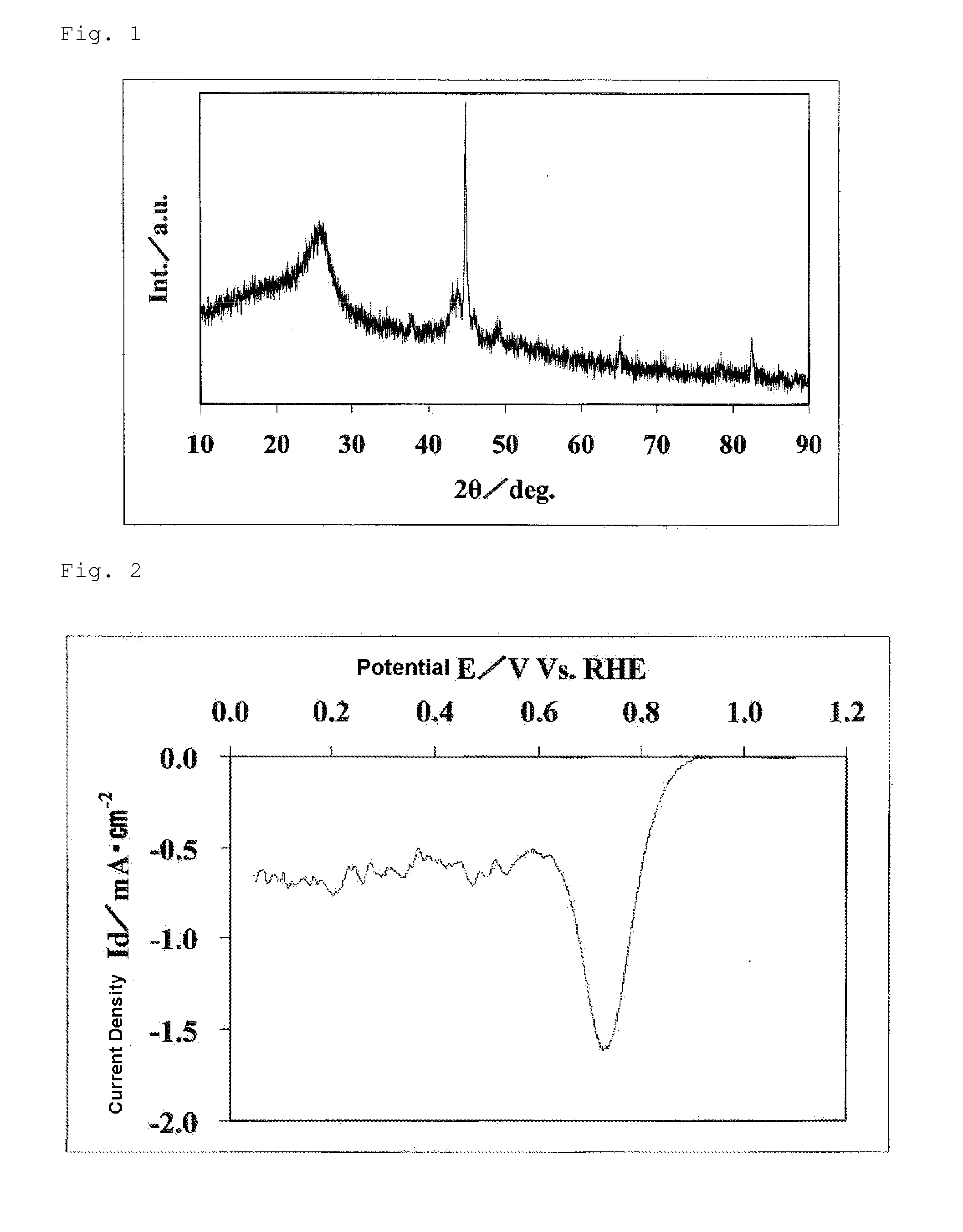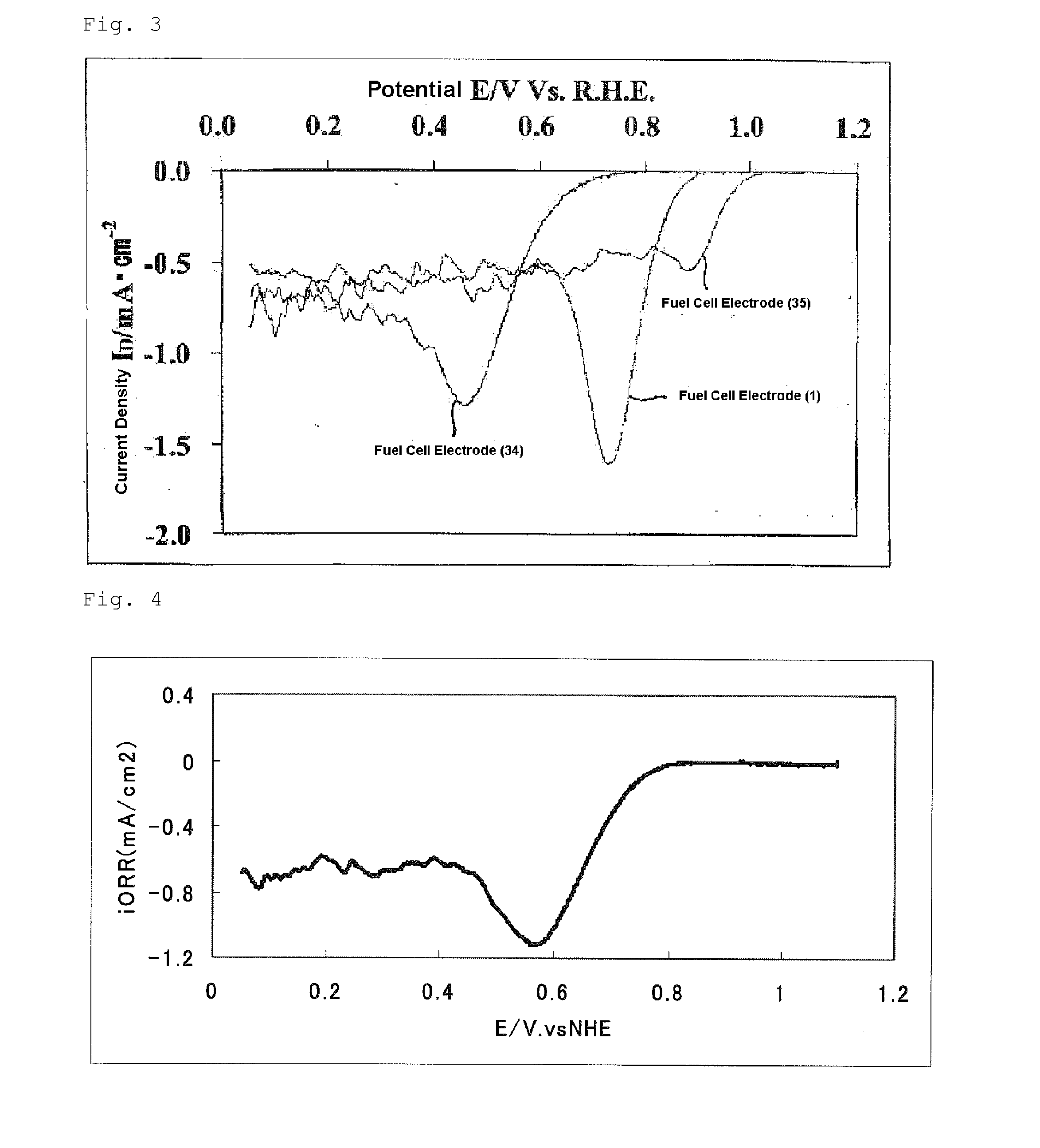Process for producing oxygen reducing catalyst and uses thereof
a technology of oxygen reducing catalyst and oxygen reducing ability, which is applied in the direction of physical/chemical process catalyst, electrochemical generator, cell component, etc., can solve the problems of insufficient oxygen reducing ability, unsatisfactory practical use performance, and high cost of noble metals, and achieve the effect of sufficient oxygen reducing ability in practical us
- Summary
- Abstract
- Description
- Claims
- Application Information
AI Technical Summary
Benefits of technology
Problems solved by technology
Method used
Image
Examples
example 1
[0160]10.043 g of glycine and 0.582 g of iron acetate were weighed and dissolved in 120 ml of water to obtain an aqueous solution. To 5.118 ml of acetylacetone, 32 ml of acetic acid was added to obtain a mixed liquid. The mixed liquid was added to the aqueous solution, and these were sufficiently stirred. The resultant solution had pH of 3.3. The resultant solution was treated at 60° C. on a water bath with an evaporator, to be dried. The resultant solid substance was crushed with a mortar. This crushed product was introduced to a quartz tubular furnace. The furnace was filled with a mixed gas atmosphere of a hydrogen gas and a nitrogen gas containing 4 vol % of a hydrogen gas. The temperature in the furnace was increased to 900° C. at a heating rate of 20° C. / min, and was retained for 60 minutes, whereby the crushed product was heat-treated. Thereafter, the product was allowed to cool, and an iron oxycarbonitride was obtained. The resultant iron oxycarbonitride was crushed with a m...
example 2
[0165]By the same operation as in Example 1 except that 10.043 g of glycine was replaced by 11.919 g of alanine, a sample powder (hereinafter referred to as the “catalyst (2)”.) was obtained. The catalyst precursor solution had pH of 3.2.
[0166]The result of the elemental analysis of the catalyst (2) is shown in Table 1. The proportion of the atomic number of iron, the atomic number of carbon, the atomic number of nitrogen and the atomic number of oxygen is represented by iron:carbon:nitrogen:oxygen=1:x:y:z. The values x, y and z are shown in Table 1.
[0167]Regarding the catalyst (2), the oxygen reduction current density obtained in the evaluation of the oxygen reducing ability and the BET specific surface area are shown in Table 1. From this oxygen reduction current density, the catalyst (2) was found to have high catalytic performance. The electrode used in this evaluation was defined as a fuel cell electrode (2).
example 3
[0168]By the same operation as in Example 1 except that 10.043 g of glycine was replaced by 8.838 g of glycylglycine, a sample powder (hereinafter referred to as the “catalyst (3)”.) was obtained. The catalyst precursor solution had pH of 3.3.
[0169]Regarding the catalyst (3), the oxygen reduction current density obtained in the evaluation of the oxygen reducing ability and the BET specific surface area are shown in Table 1. From this oxygen reduction current density, the catalyst (3) was found to have high catalytic performance. The electrode used in this evaluation was defined as a fuel cell electrode (3).
PUM
| Property | Measurement | Unit |
|---|---|---|
| Temperature | aaaaa | aaaaa |
| Percent by mass | aaaaa | aaaaa |
| Cooling rate | aaaaa | aaaaa |
Abstract
Description
Claims
Application Information
 Login to View More
Login to View More - R&D
- Intellectual Property
- Life Sciences
- Materials
- Tech Scout
- Unparalleled Data Quality
- Higher Quality Content
- 60% Fewer Hallucinations
Browse by: Latest US Patents, China's latest patents, Technical Efficacy Thesaurus, Application Domain, Technology Topic, Popular Technical Reports.
© 2025 PatSnap. All rights reserved.Legal|Privacy policy|Modern Slavery Act Transparency Statement|Sitemap|About US| Contact US: help@patsnap.com


